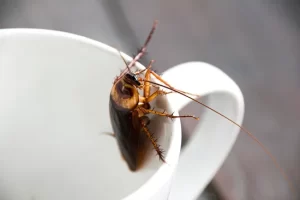Cockroaches
 There are about 4,500 species of cockroach, of which 30 species are associated with human habitations and about four species are well known as pests.
There are about 4,500 species of cockroach, of which 30 species are associated with human habitations and about four species are well known as pests.
Among the best-known pest species are the American cockroach, Periplaneta americana, which is about 30 millimeters (1.2 in) long, the German cockroach, Blattella germanica, about 15 millimeters (0.59 in) long, the Asian cockroach, Blattella asahinai, also about 15 millimeters (0.59 in) in length, and the Oriental cockroach, Blatta orientalis, about 25 millimeters (0.98 in).
Behavior
Cockroaches live in a wide range of environments around the world. Pest species of cockroaches adapt readily to a variety of environments, but prefer warm conditions found within buildings. Many tropical species prefer even warmer environments and do not fare well in the average household.
The spines on the legs were earlier considered to be sensory, but observations of their locomotion on sand and wire meshes have demonstrated that they help in locomotion on difficult terrain. The structures have been used as inspiration for robotic legs.
Cockroaches leave chemical trails in their feces as well as emitting airborne pheromones for swarming and mating. Other cockroaches will follow these trails to discover sources of food and water, and also discover where other cockroaches are hiding. Thus, cockroaches can exhibit emergent behavior, in which group or swarm behavior emerges from a simple set of individual interactions.
Research has shown that group-based decision-making is responsible for complex behavior such as resource allocation. In a study where 50 cockroaches were placed in a dish with three shelters with a capacity for 40 insects in each, the insects arranged themselves in two shelters with 25 insects in each, leaving the third shelter empty. When the capacity of the shelters was increased to more than 50 insects per shelter, all of the cockroaches arranged themselves in one shelter. Researchers found a balance between cooperation and competition exists in group decision-making behavior found in cockroaches. The models used in this research can also explain the group dynamics of other insects and animals.
Cockroaches are mainly nocturnal and will run away when exposed to light. A peculiar exception is the Asian cockroach, which is attracted to light.
Role as pests
Cockroaches are one of the most commonly noted household pest insects. They feed on human and pet food, and can leave an offensive odor. They can also passively transport microbes on their body surfaces including those that are potentially dangerous to humans, particularly in environments such as hospitals.
Cockroaches have been shown to be linked with allergic reactions in humans. One of the proteins that triggers allergic reactions has been identified as tropomyosin. These allergens have also been found to be linked with asthma.
General preventive measures against household pests include keeping all food stored away in sealed containers, using garbage cans with a tight lid, frequent cleaning in the kitchen, and regular vacuuming. Any water leaks, such as dripping taps, should also be repaired. It is also helpful to seal off any entry points, such as holes around baseboards, in between kitchen cabinets, pipes, doors, and windows with some steel wool or copper mesh and some cement, putty or silicone caulk.
Some cockroaches have been known to live up to three months without food and a month without water.
Frequently living outdoors, although preferring warm climates and considered “cold intolerant,” they are resilient enough to survive occasional freezing temperatures. This makes them difficult to eradicate once they have infested an area.

